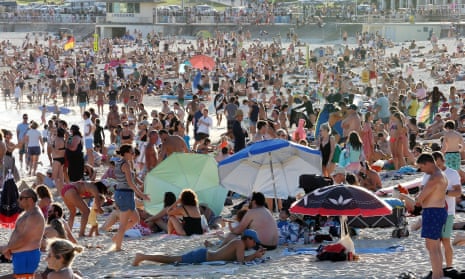The age group most represented in Australian statistics for confirmed cases of Covid-19 are people in their 20s, because they are the group most likely to travel or party with returned travellers, experts have said.
Data updated daily by the federal health department shows that 11.3% of confirmed cases of the coronavirus in Australia are among people aged 25 to 29, followed by 9.5% in those aged 60 to 65 – the cruise ship cohort – and 9.3% in those aged 20 to 25.
People aged 80 and older account for just 2.7% of the confirmed cases of Covid-19 but 47% of the deaths. As of 31 March, 19 people have died after testing positive to Covid-19 in Australia. The youngest was a 68-year-old man from Queensland, although a 36-year-old Australian man who had tested positive to Covid-19 died in a hospital in Iceland earlier this month.
To date, just 29 cases have been recorded in Australia in children under the age of 10, of which 15 were in children under five. All were family members of adults who had travelled overseas.
Prof Lyn Gilbert, a senior researcher from the University of Sydney’s Marie Bashir Institute for Infectious Diseases and Biosecurity and chair of an expert panel advising the Australian Health Protection Principal Committee on its response to Covid-19, said the Australian data skewed young because both infection and testing had to date been concentrated on returned travellers, and known contacts.
There have also been clusters of infections caused by returned travellers not realising they were unwell – two at a wedding and one among backpackers at Bondi Beach – which included a significant number of younger people.
“Where young people gather in tight groups and socialise, they tend to get infected,” Gilbert said.
There is, Gilbert said, still a feeling among some younger adults that they need not take the same precautions.
“There is a feeling that it doesn’t affect them, they are not going to get sick,” she told Guardian Australia. “And mostly they are not – they won’t get a severe illness. But they pass it on.”
Just under a third of all confirmed cases of Covid-19 in Australia are in people aged 60 and over, the age at which the risk of severe illness begins to escalate.
Those lower numbers were a good thing, said Gilbert, because “a proportion of those people are going to die”.
Prof Peter Collignon, an infectious disease expert from the Australian National University, said the Australian data was a reflection of the demographics engaging in overseas travel. That is also shown in the location data, which is clustered around affluent suburbs in Sydney and Melbourne.
Both Gilbert and Collignon said the concentration of cases either in or connected to returned travellers, as opposed to untraced community transmission, meant it was possible the spread of the disease in Australia could be slowed.
“I actually think we are really likely to not only flatten the curve but make the curve go in the other direction, which is down,” Collignon said.
The rate of growth has already slowed, according to the health minister, Greg Hunt. Last week the number of cases in Australia grew by between 25% and 30% per day; the three-day average to Tuesday 31 March was a 9% increase.
Collignon said that unlike the United States, Italy and the United Kingdom, Australia did not appear to have widespread undetected community transmission.
In those places, he says, the virus spread undetected for as long as six weeks. If that had occurred in Australia, he said, the next stage of the outbreak would be to see people over the age of 50, or with vulnerabilities, turning up sick in hospital. Hospitals in Australia have been testing people with respiratory or unknown conditions for Covid-19, for weeks, and had very few positive results.
“All the available data is that we don’t have a lot of widespread, silent spread in Australia because we would be picking up those serious cases, and we are not,” Collignon said.
Australia has broadened its testing criteria as the number of returned travellers has decreased to a manageable level. In Western Australia, anyone from a high-risk group – such as healthcare workers, police, residents of an aged care home, people who live in remote Aboriginal communities, or people in a prison – can now get tested if they have symptoms.
Collignon said that broader testing is a good thing but that suggestions Australia has missed a significant proportion of cases by not doing widespread testing earlier were incorrect. As of this week, about 1.9% of tests for Covid-19 in Australia have returned a positive result and about 8,900 tests have been performed per million people.
As of 20 March, according to data compiled by Our World In Data, Australia had done more tests for the number of confirmed cases than any country other than Russia.
“A higher positivity rate means you are really missing a lot of cases,” Collignon said.
Gilbert said the outbreak in Australia could not be compared to the outbreaks in Italy and the US.
“We are much closer to Singapore, Hong Kong and Taiwan,” she said, with the difference that those countries introduced stricter social distancing rules more swiftly than Australia.
“Although people now appreciate that social distancing is necessary, it does cause enormous hardship and in the absence of community transmission [we] would have been introducing those measures and causing that hardship earlier than we needed to be.”
Both said that suggestions Australia was missing a significant number of cases were not borne out by the data.
“All of the data suggests we are getting a fair bit of the iceberg and not just the tip of the iceberg,” Collignon said. “We are getting 95% of the iceberg.”
